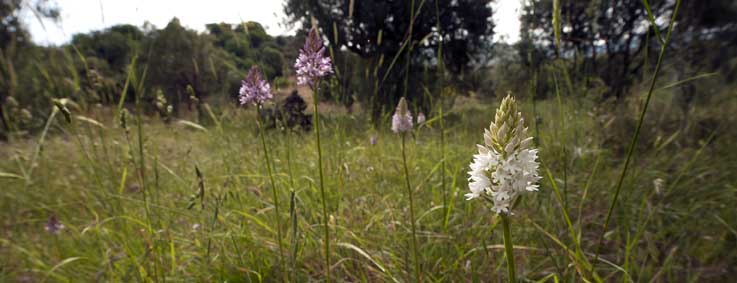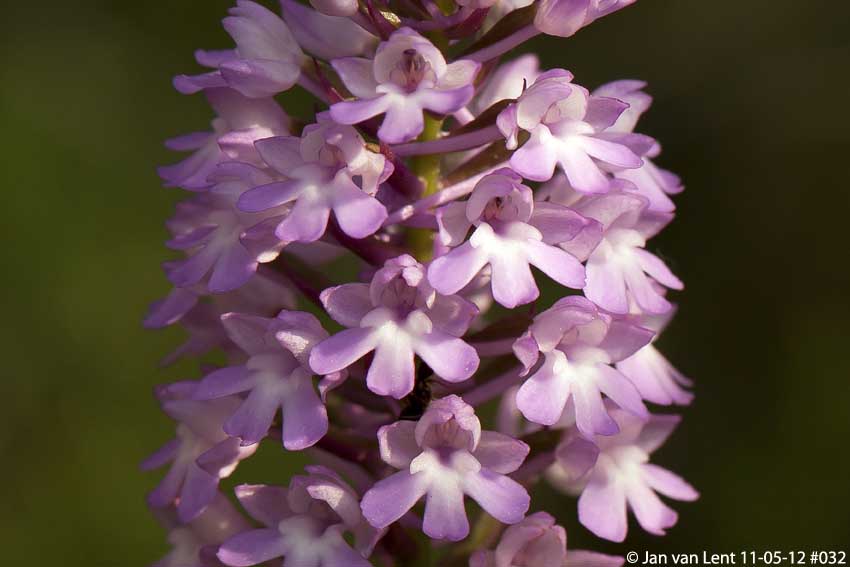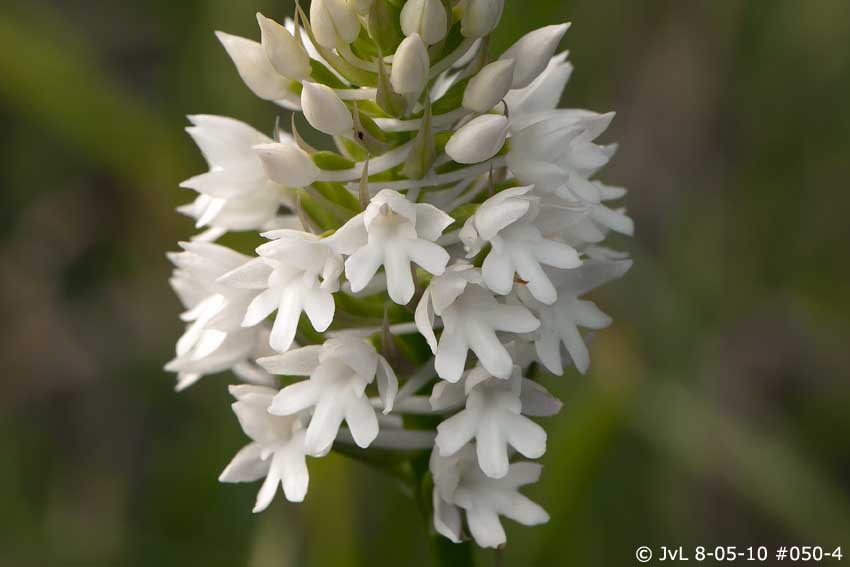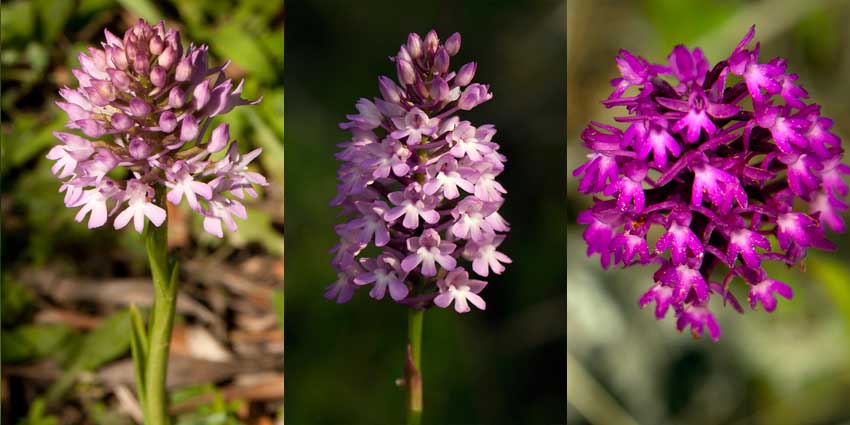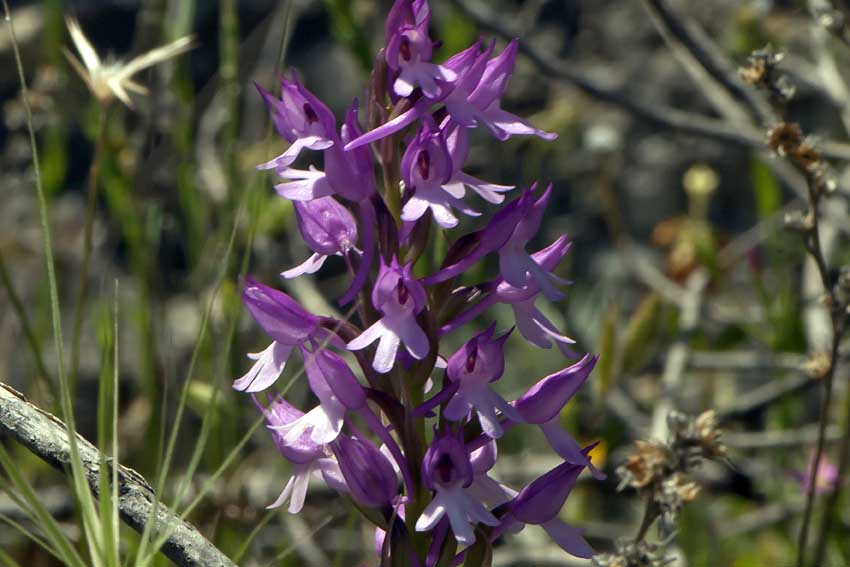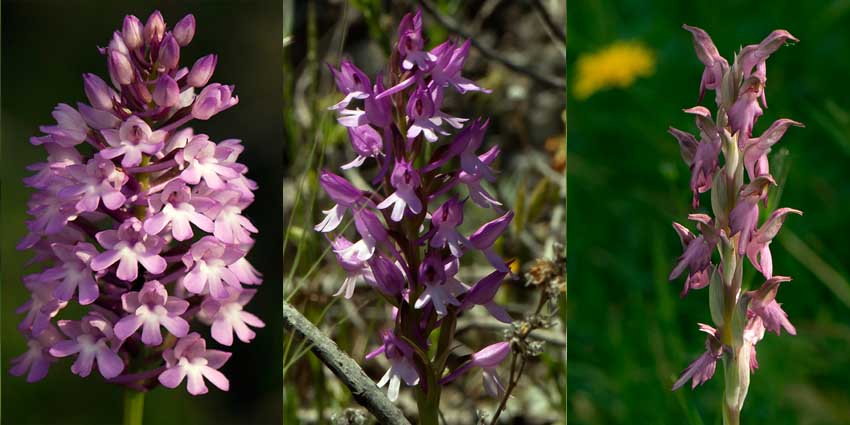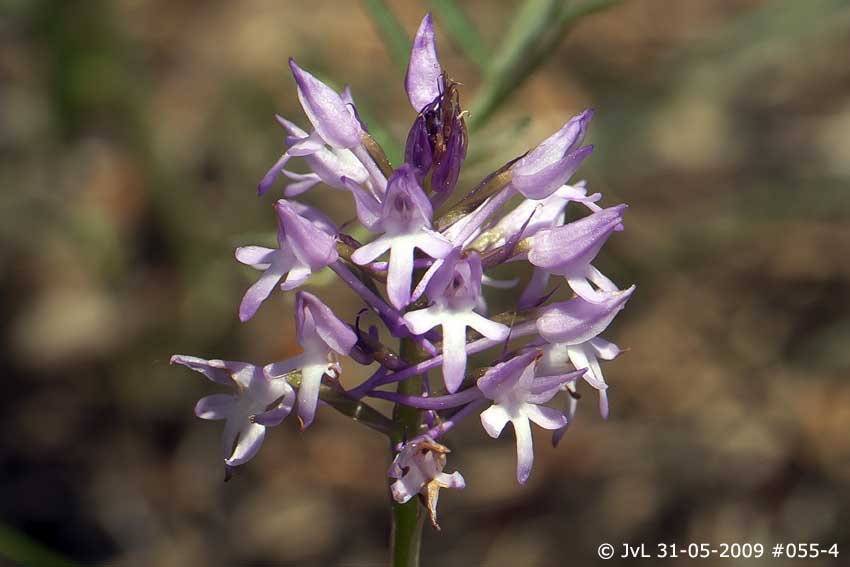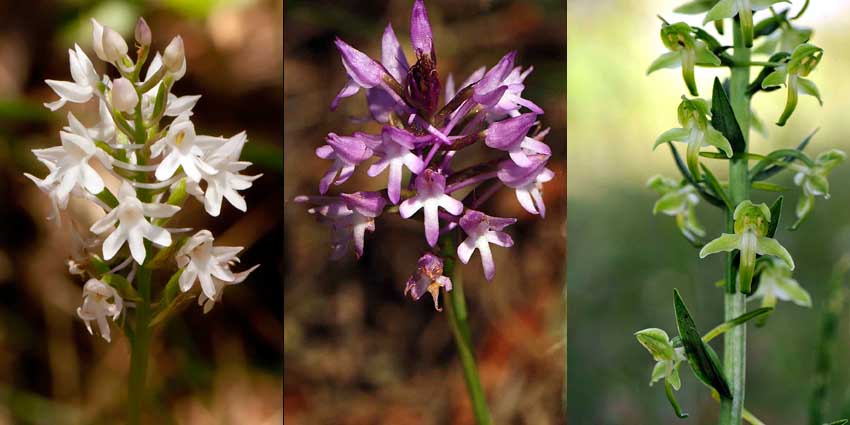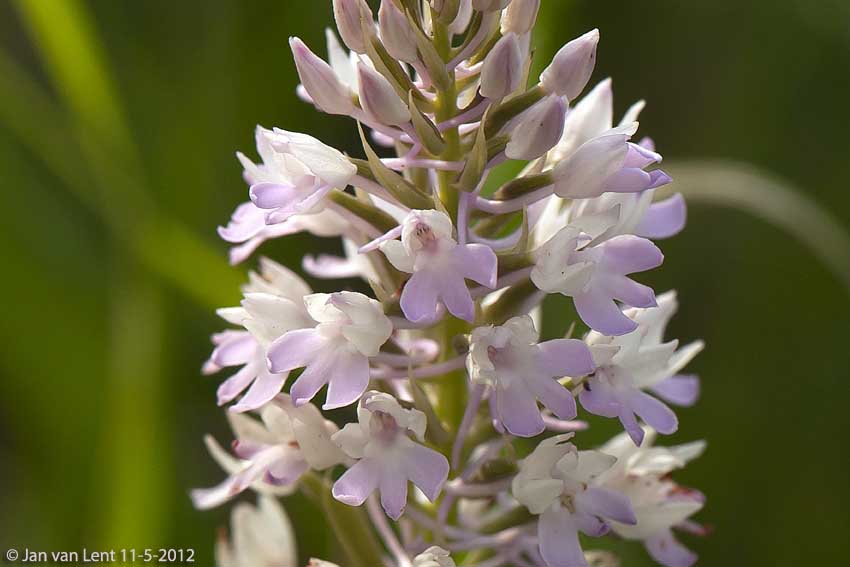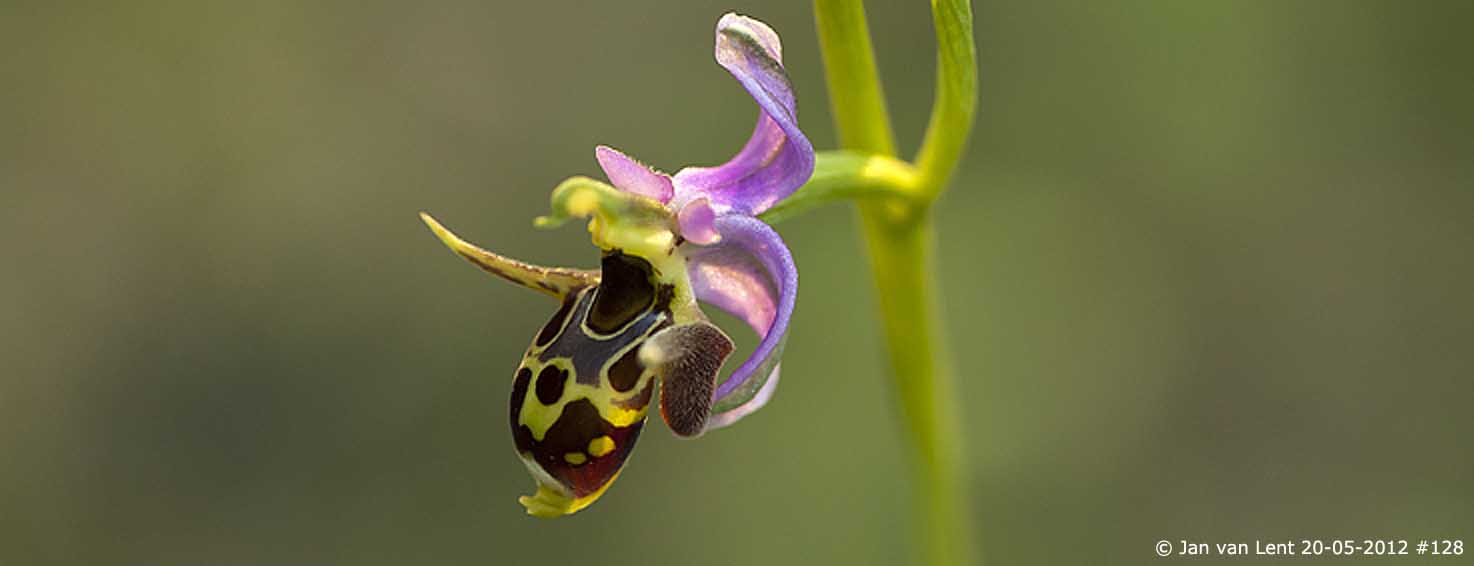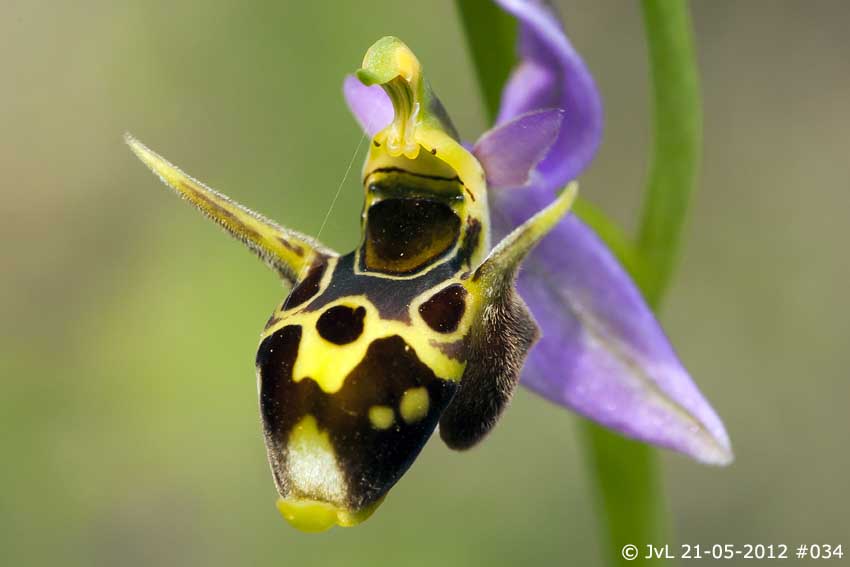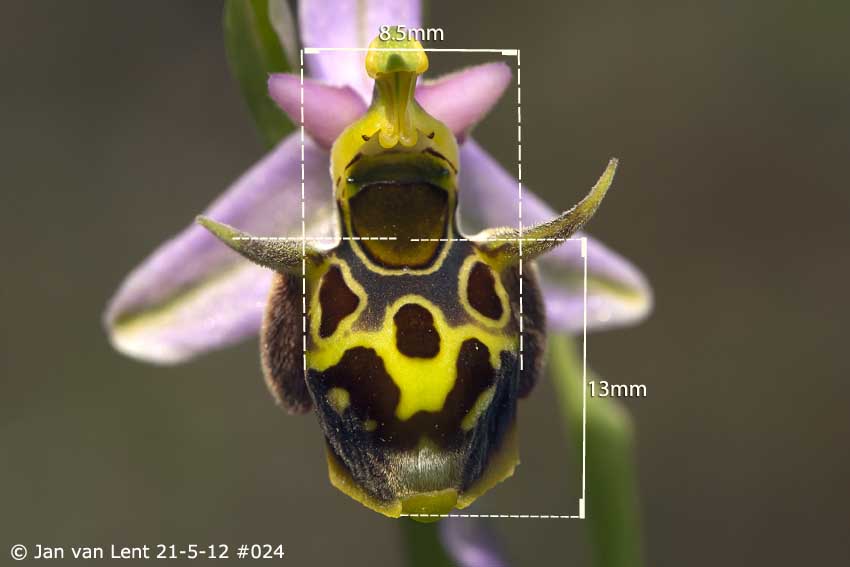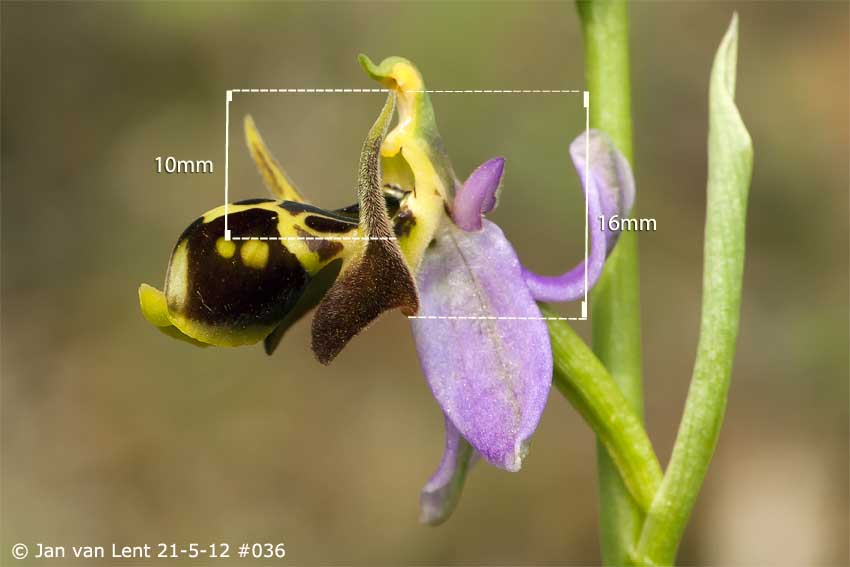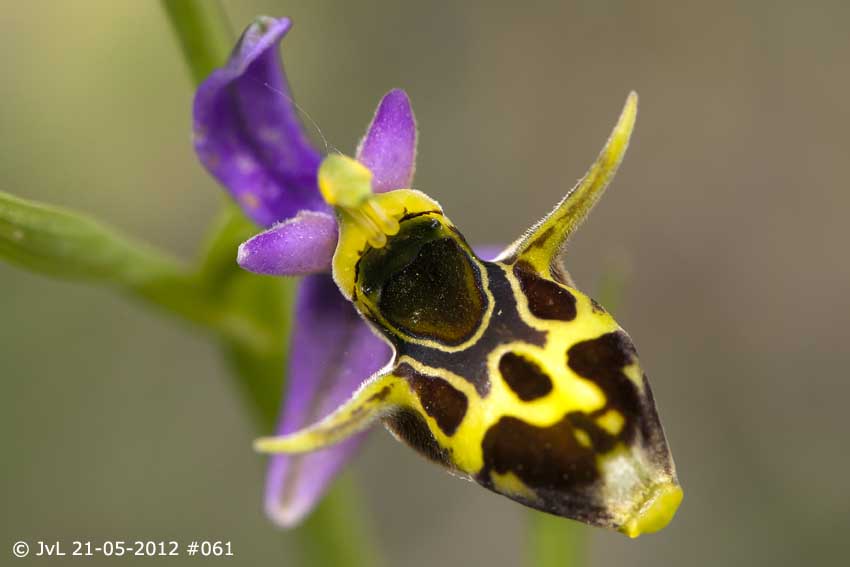Habitat: Eftalou.
Anacamptis pyramidalis, Eftalou © JvL 8-05-10 #079
Anacamptis pyramidalis (L.) L.C.M. Richard (De Orchid. Eur.) 1753.
HABITAT: In Blog 11 I wrote about Anacamptis pyramidalis: ‘An easy Orchid, no groups around, no complications about names whatsoever, just simply red, pink and white flowers.’ And then I found Ophrys phrygia in Eftalou (see Blog 11: Oh Yes, It Is!’ http://www.janvanlent.com/blog/?p=1012). So now back to the Pyramidal Orchid. Anacamptis pyramidalis is not a difficult to identify orchid, it’s flowering everywhere on Lesvos between the end of April and the beginning of June. But I also already found (between Vatera and Nifida) some small ‘brachystachys’ species at the end of March. The genus Anacamptis is close to Orchis but is distinguished by the 2 ridges at the base of the lip and the single retinacle (viscidium) bearing both pollinia.
Anacamptis pyramidalis ‘nominate form’, Eftalou, © JvL 11-05-12 #032
The colours of the flowers are almost never completely identical: red (sometimes in the south near Megalochori), pink (everywhere on the island) and white (Eftalou, Agiasos, Alifantá). And in Eftalou I found also species with a pink lip and white sepals & petals, so a bicolour version! And not only the colour but also the form of the inflorescence has some differences: round, pyramid or conical. This has often to do with the age of the plant (young: round, middle age: pyramid, older: conical) but there also some described variations of Anacamptis in literature (and in nature) which always have these characteristics. And last but not least: I found species with a height from 10 centimetres but also from 50 centimetres! So let’s see if I perhaps found in Eftalou a previously undescribed variation.
Anacamptis pyramidalis var. albiflora, Eftalou, © JvL 8-05-10 #050
RESEARCH: Let’s start with ‘the old master’ SUNDERMANN (1980). He has 2 variations: var. albiflora with white flowers and var. tanayensis with dark purple flowers growing in the Alps between 1200 and 1900 meter. Well, Eftalou is certainly not in the Alps and yes, we’ve got here a lot of var. albiflora.
KREUTZ (1998) found in Turkey also a few variations: Anacamptis pyramidalis var. brachystachys (D’Urville) Boissier, with smaller, light coloured flowers and a lax inflorescence and plants which look similar to Anacamptis pyramidalis var. tanayensis Chevenard. Ah, yes similar, because the Alps are not in Turkey… And var. albiflora is also present in Turkey. And let’s see which variations he (KREUTZ 2002) found on Rhodes and Karpathos: ‘Flower coloration of Anacamptis on Rhodes and Karpathos is mainly pink. One can also find a surprising number of white-coloured specimens, as well as all colour variations from yellowish-white to violet-red.’ But Kreutz didn’t give names to those variations in this book.
And in his Cyprus book (KREUTZ 2004) he wrote: ‘Shape and flower colour of the species are variable on Cyrus. One can find plants with pure white, light or deep pink flowers. There are also small and compact plants, where the flowers have fairly wide middle lobes, and slender, relatively tall specimens with narrower middle lobes.’
So there is not much difference between the pyramidalis from Cyprus and from Lesvos I thought. But then he continues: ‘The plants in the Mediterranean region (thus also on Cyprus) are often separated from the nominate species as Anacamptis pyramidalis var. brachystachys (D’Urville) Boissier or as Anacamptis pyramidalis var. urvilleana (Sommier et Gatto) Schlechter. Both varieties differ from the nominate form by a more compact appearance, paler and smaller flowers and a lax inflorescence. Anacamptis pyramidalis var. urvilleana was described from Malta, and is probably identical to the variety brachystachys. Remarkably, the nominate form also occurs on Malta, but flowers three weeks later than the variety urvilleana. The occurrence of two Anacamptis pyramidalis taxa, which are so dissimilar in appearance, flower shape and flowering time, is so far unknown elsewhere in the southern Mediterranean.’
Earliest: ‘brachystachys’ 27-3-10 #070, ‘nominate’ pyramidalis: 11-5-12 #032, latest:
‘X Anacamptorchis’ Megalochori 3-6-11 #026, © JvL A.pyramidalis on Lesvos.
I’m glad that he wrote ‘southern Mediterranean’ because here in the ‘northern Mediterranean’ in Lesvos, we’ve also got two or more different taxa ‘dissimilar in appearance, flower shape and flowering time’!
DELFORGE (2005): ’(Anacamptis pyramidalis) varies in size, shape of inflorescence and degree of indentation and colour of lip. Several variants have been named which, on account of numerous intergrades, probably have little evolutionary significance.’
But then he described four variations: ‘‘urvilleana’: rather early, with small pale flowers (Malta, Crete, Karpathos); probably inseparable from ‘brachystachys’: inflorescence near globular, rather lax, flowers pale (Mediterranean region, also Portugal); ‘tanayensis’: inflorescence dense, flowers bright red, median lobe of lip prominent, broad and protuberant, spur rather short, frequent above 1300m in the Alps. ‘sanguinea’: a red-flowered morph from Ireland.’
And Delforge has also his own isolated variation: Anacamptis pyramidalis var. nivea P.DELFORGE. It is a snow-white variation from Greece (Etolia-Akarnania) with reduced basal ridges and a thin, short spur.
Who is next? BAUMANN, KÜNKELE, LORENZ (2006). They also have var. tanayensis, small flowers, dark red, short spur (Swiss) and var. urvilleana, elegant, light coloured, early flowering. (South Mediterranean, Cyclades, Malta).
On Chios A. pyramidalis is almost growing everywhere, but I see only the ‘normal’ nominate form. (TAYLOR, Chios 2012).
Even KRETZSCHMAR/ ECCARIUS/ DIETICH: The Orchid Genera Anacamptis, Orchis, Neotinea. (2007) don’t have exceptional new information, at least not with this genus. I even don’t have to change its name…
And KARATZÁ (2008) has for Lesvos besides the normal Anacamptis pyramidalis and Anacamptis pyramidalis var. albiflora (which he also calls: ‘nivea’ P.DELFORGE) an
X Anacamptorchis lesbiensis B.BIEL. This is a hybrid between Anacamptis pyramidalis and Orchis sancta. He described this species from Kratigos and Ag.Marina in the south of Lesvos, behind Mytilini and the airport. I’m wondering if a hybrid I found in Plakes (between Vatera and Nifida on the coast) is the same species. It looks like a hybrid between Anacamptis and Orchis tridentata, but that cannot be true I know now (because A. pyramidalis has 36, Anacamptis (was Orchis) tridentata 42 chromosomes. But if you compare the sepals & petals in the middle photograph with the sepals & petals of the far right photograph, you might think so.
X Anacamptorchis lesbiensis, Plakes, © JvL 10-05-09 #060
Anacamptis pyramidalis; X Anacamptorchis lesbiensis; Anacamptis sancta.
Another variation I found in the neighbourhood of Sanatorio (Agiasos): It looks like a hybrid between Anacamptis pyramidalis and Platanthera holmboei. In literature there is only one such hybrid described: X Anacamptiplatanthera payotti Fournier 1928 or Nothogenus Anacamptiplatanthera (Anacamptis x Platanthera) P.Fourn. 1928. This is (as the name already shows) a hybrid between Anacamptis pyramidalis and Platanthera bifolia. We don’t have (as far as I know) Platanthera bifolia on Lesvos, but we have Platanthera holmboei and chlorantha!
X Anacamptiplatanthera? © JvL 31-05-2009 #058 Sanatorio.
Anacamptis pyramidalis var. albiflora, Sanatorio 31-05-2009; X Anacamptiplatanthera?, Sanatorio 31-05-2009; Platanthera holmboei, chestnut forest above Sanatorio, 26-05-2011 #013
BOTTOM LINE: Maybe one of the interesting aspects of Anacamptis is not just the variants but also the hybrids with other orchid members. Delforge in his ‘notes’ about Anacamptis: ‘Hybridises very rarely with a few species of Orchis (X Anacamptorchis), extremely rarely with Serapias and Gymnadenia, and doubtfully with Dactylorhiza and Platanthera’…
Let’s summarize which Anacamptis I found on Lesvos: First of course the ‘nominate form’ Anacamptis pyramidalis and second the white variation ‘albiflora’. Then from the other Anacamptis variations ‘brachystachys’ = ‘urvilleana’: - inflorescence near globular, rather lax, flowers pale (see earliest: 27-3-10 #070).
There are 15 different X Anacamptorchis described on the internet, so on Lesvos we have for sure X Anacamptorchis lesbiensis B.Biel (described from Lesvos) but maybe also a hybrid between Anacamptis pyramidalis and Orchis morio (ssp.picta) =
X Anacamptorchis laniccae.
But the most beautiful Pyramidal Orchid was the bicoloured version I found in Eftalou this year: Anacamptis pyramidalis var. bicolour. So far I couldn’t find a bicoloured version in literature and one the internet, and if I really wanted to put my hand (name) in the Hornets Nest I should write: Anacamptis pyramidalis var. bicolor van Lent 2012…
Jan van Lent, Lesvos, 22-6-2012.
Revision: 9-8-2013.
Revision: 20-5-2014
Radiohead: ‘Pyramid song’ (movie: Der Himmel über Berlin.)http://www.youtube.com/watch?v=ee05p1I464s
Anacamptis pyramidalis var. bicolor, Eftalou, © JvL 11-05-12 #028 (4)

